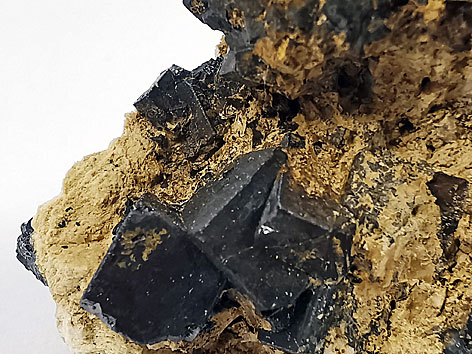|
Bixbyit-Gruppe
(Bixbyit-(Fe) und Bixbyit-(Mn)
|
|
Formel:
|
(Mn3+,Fe3+)2O3
(4.CB.10; Bixbyit-Gruppe)
|
|
Ausbildung:
|
kubisches Kristallsystem; meist schwarze,
metallisch glänzende, kubische Kristalle und
Kombinationen sowie Kristallzwillinge
|
|
Entdeckung:
|
1897 - Penfield & Foote; benannt zu Ehren von
Maynard Bixby (1853 – 1935),
amerikanischer Mineraliensammler und -händler,
welcher die ersten Bixbyit-Exemplare sammelte
und lieferte, Autor und Erforscher des
Thomas-Gebirges (Utah). Nach Miyawaki & Hatert &
Pasero & Mills (2022) als Bixbyit-Gruppe mit den
Spezies Bixbyit-(Fe) und Bixbyit-(Mn) neu
definiert (IMA 2021-H).
|
|
Typlokalität:
|
USA, Utah, Juab Co., Thomas Range, Maynard's
Claim (Pismire Knolls)
|
|
Seltenheit:
|
wenig verbreitet
(Mineralienatlas: 91 / Mindat: 120 Lokalitäten;
2023)
|

Bixbyit xx neben
Hausmannit xx auf Baryt
Gottlob bei Friedrichroda, Thüringen, BRD
Stufe: 6,8 x 5 cm
|

Bixbyit xx
Detail der links abgebildeten Stufe
Bildbreite: 5 mm
|

Bixbyit xx
Ültevis, Jokkmokk, Provinz Norrbotten, Schweden
Stufe: 7,0 x 5,5 cm
|

Bixbyit xx
Detail der links abgebildeten Stufe
Bildbreite: 27 mm
|
|

Bixbyit xx neben
Pseudobrookit xx und Topas xx
Thomas Range, Juab Co., Utah, USA
Bildbreite: 8
cm
|

Bixbyit-Kristall
Detail der links abgebildeten Stufe
Bildbreite: 12 mm
|

Bixbyit xx neben Manganit
N`Chwaning II Mine, Kalahari Manganfeld,
Nordkap, Südafrika
Stufe: 3,2 x 2,8 cm
|

Bixbyit xx
Detail der links abgebildeten Stufe
Bildbreite: 16 mm
|







